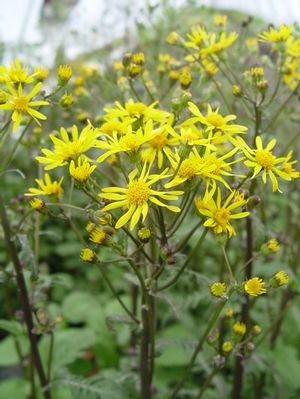New Moon Nurseries
Senecio aureus
Golden ragwort
Native to North America
FIRST IMPRESSIONS: Senecio aureus is a mounding perennial with shiny heart shaped basal leaves. In spring clusters of golden-yellow daisies rise above the foliage on sturdy stems. Plants form large colonies over time in wet or moist woodlands.
HABITAT & HARDINESS: The range of Senecio aureus extends from Newfoundland and Labrador to Florida and west from Manitoba to Arkansas, Oklahoma and Texas.
Plants are indigenous to wet or mesic deciduous woods, damp woodland clearings and borders, moist sandy savannas, sandy swamps, bogs, seeps, banks of rivers and lakes, glades, moist meadows and abandoned fields.
Plants are hardy from USDA Zones 4-9.
PLANT DESCRIPTION: Senecio aureus is an upright perennial wildflower. In favorable sites plants expand into colonies from underground rhizomes.
The basal leaves are 2-3” long and heart shaped. The blades are toothed with long petioles. They are shiny above with purple color beneath. They are pubescent when young and smooth with age.
The leaves are clustered into a rosette with a flowering stalk that emerges from the center. The leaves on the stalk are alternate and pinnately lobed.
The stalk terminates in a flat headed corymb of ½” flowerheads. The daisy-like heads emerge from unusual purple buds.
Each “daisy” center consists of many disc florets surrounded by 6-16 yellow ray florets. Blooming begins in spring and lasts for about 3 weeks.
Both ray and disc florets mature into bullet-shaped achenes each with a white hairy pappus. The fluffy pappus allows the achenes to be distributed by the wind.
Plants grow 1-2’ tall with 1’ spread.
CULTURAL & MAINTENANCE NEEDS: Senecio aureus flourishes in part sun or part shade in wet to mesic sites. Plants need abundant moisture and appreciate a soil high in organic matter.
This species is fairly pest resistant and is unpalatable to deer and other herbivores.
LANDSCAPE USES: This is a good choice for a Groundcover, Grouping or Mass in a Shade Garden. Senecio aureus has Showy Blooms and can be used as a Cut Flower and in Cottage Gardens, Deer Resistant Plantings, Low Maintenance Plantings, Moist Meadows, Perennial Borders, Roadsides, Restoration Projects and Wildlife Gardens.
COMPANION & UNDERSTUDY PLANTS: At woods edge try pairing Senecio aureus with Amsonia tabernaemontana, Aster divaricata, Helianthus decapetalus, Phlox divaricata, Dryopteris marginalis and Polystichum acrostichoides.
Senecio smallii is an upland version of S. aureus which can be substituted in drier sunnier sites.
TRIVIA: Several species of small bees, bumblebees, butterflies, hoverflies and pollinating flies seek nectar and pollen from the flowers. Plants host Northern Metalmark Butterfly caterpillars. The foliage is toxic to most herbivores except for sheep
Senecio aureus was known as “Life Root” by the Eclectic Herbalists because of its use as a tonic for the uterus. It was also one of the ingredients in Lydia Pinkham’s herbal women’s tonic which was very popular from the late 1800’s into modern times.
This species is also known as Packera aurea.
The generic name Senecio is from the Latin word senex meaning “old man” due to the achene’s silvery pappus.
Senecio aureus can be differentiated from other Senecio spp. by its strongly rounded to heart shaped basal leaves. Other species tend to have narrower oval to elliptical basal leaves. Senecio aureus is also more shade tolerant than most other species.
Height:
1-2 ftSpread:
1 ftSpacing:
18 inUSDA Hardiness Zone:
4-9Bloom Color:
YellowSenecio aureus Characteristics
Attracts Wildlife
- Pollinators
- Butterflies
Attributes
- Ground Cover
- East-Coast Native
- Cut Flower
- Bog
- Rain Garden
Exposure
- Partial Shade
Deer Resistant
- Deer Resistant
Flowering Months
- May
Foliage Color
- Green
Growth Rate
- Medium
Season of Interest (Foliage)
- Summer
- Spring
- Fall
Soil Moisture Preference
- Moist to Wet
Interesting Notes:
For more information on this plant, visit the USDA PLANTS Database: http://plants.usda.gov/java/profile?symbol=PAAU3
